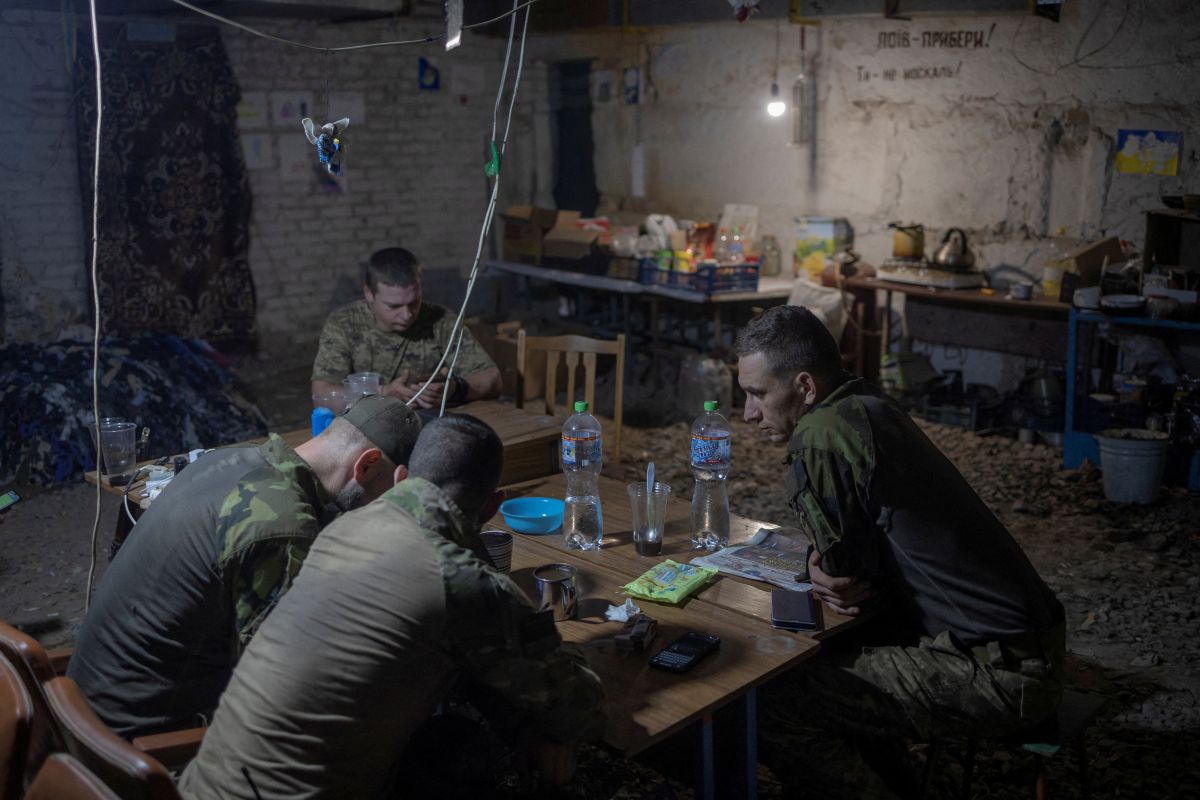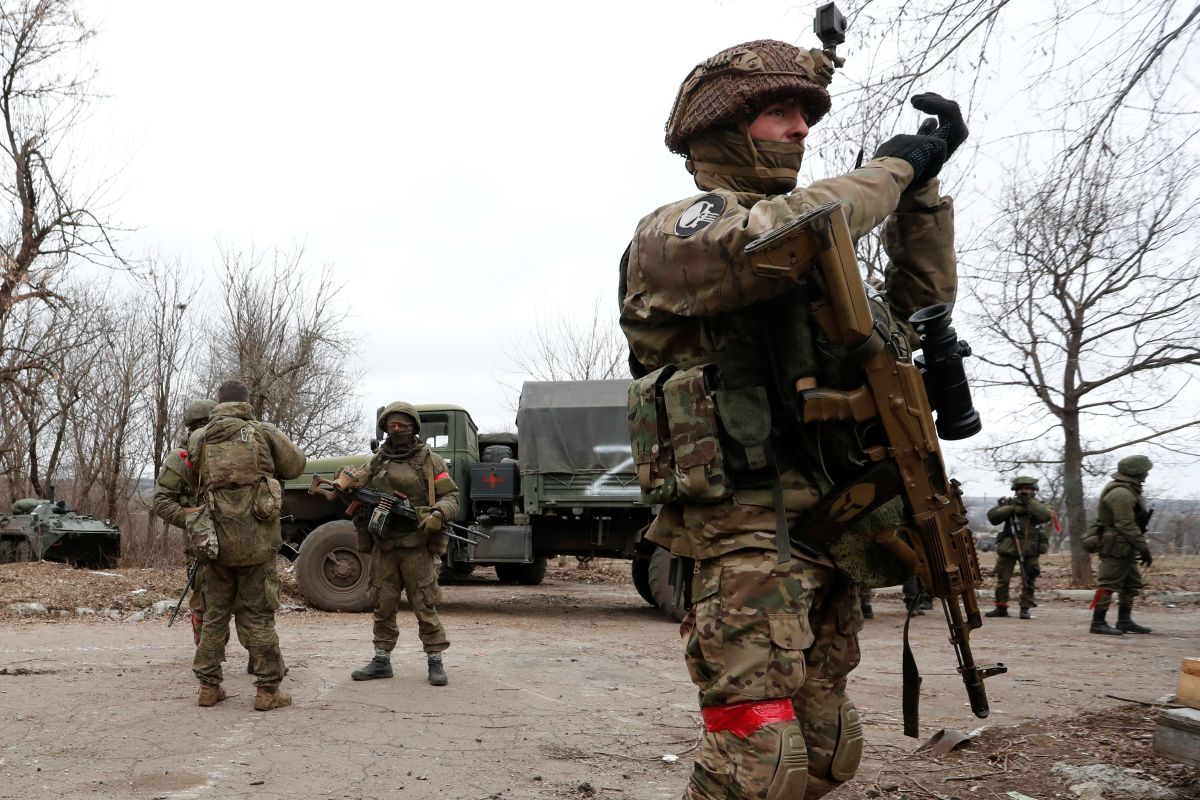Ukrainians Resist in the Occupied South
Since mid-April this year, acts of sabotage and subversion against the occupation forces, attacks on local collaborators, and information and psychological operations have been taking place in the southern areas of Ukraine. Their aim is to weaken the morale of the Russian troops, discourage the local population from collaborating, and maintain their determination to oppose the occupation authorities. At present, the scale and scope of these activities are insufficient to contribute to changing the operational situation on the southeastern front; however, strengthening the resistance movement to intensify its activities could play an important role in a potential Ukrainian counter-offensive.
 MARKO DJURICA/Reuters/Forum
MARKO DJURICA/Reuters/Forum
Russia occupies about 20% of Ukrainian territory (including Crimea), and in the south of the country it holds about 95% of Kherson Oblast and 60% of Zaporizhzhia Oblast. The city of Zaporizhzhia remains under Ukrainian control, but other major cities in the region (e.g., Kherson, Novaya Kakhovka, Melitopol, Enerhodar) have been captured by Russian forces. According to the Ukrainian estimates, about half of the population of these areas (around 1.5 million people in total) has remained and are restricted or prevented from leaving by the occupiers. Those who wish to flee must undergo a process called filtration in which Russian services check their loyalty to the Ukrainian authorities. In both oblasts, Russia has set up local occupation administration structures, circulates the rouble, and applies an information blockade, with internet access only possible through Russian-controlled providers.
Resistance Activity in Southern Ukraine
Since June, there has been a growing number of sabotage and subversive actions by the Ukrainian resistance movement in Kherson and Zaporizhzhia oblasts. On a small scale, such actions are also being carried out in Donbas. The targets of the attacks include Russian soldiers (more than 100 killed), arms depots, artillery positions and radar systems, and supply routes (e.g., railway lines, bridges). Irregular actions by Ukrainian guerrillas weaken the morale of the Russian forces and increase the cost of the occupation. Bombings targeting collaborators have made it difficult for the occupation administration to control the occupied territories. Fearing a resistance movement, some pro-Russia activists refuse to cooperate with the occupiers. Since July, the lack of local collaborators in key positions has been filled by officials brought in from Russia, which also indicates preparations for the annexation of the occupied territories. Russia has announced several times that it will hold a referendum (which would be illegal under local and international law) on whether to create a Kherson People’s Republic. To facilitate this, in June the occupiers stole lists of voters from the local administrative offices. At the same time, Russia is waging a disinformation and propaganda campaign aimed at creating the impression of the “liberation” of Kherson Oblast and the population’s support for integration with Russia. Its message is now based on reassuring the local population about the long-term Russian presence in southern Ukraine and the futility of resisting the occupier.
The Ukrainian resistance is also carrying out information and psychological activities aimed at the local population in order to sustain its morale and, above all, to discourage cooperation with Russia and encourage acts of disobedience. These are intended to depreciate the impact of the Russian propaganda and contribute to the mobilisation of the population for a massive guerrilla campaign in support of the anticipated Ukrainian counter-offensive in the south. A manual on guerrilla warfare published by the Centre for National Resistance (CNO, a special website of the Ukrainian Armed Forces to support the resistance of the civilian population) contains instructions for carrying out sabotage and subversive activities, as well as operational security rules (including communication).
The extent to which the resistance is organised and commanded is not publicly known. Most likely, its activity is coordinated by the Ukrainian Operational Command “South”, special forces (SSO), and military intelligence (GUR). Prior to the invasion, local security forces, among others, were being prepared to carry out guerrilla activities in the occupied territories. These structures were at least partially detected and neutralised by Russia in the filtration camps, where Russian troops check, among other things, the identity of individuals and their links to state structures. Most likely there were betrayals within the ranks of the Security Service of Ukraine (SBU), which led to its head, Ivan Bakanov, being dismissed in July. This may also have contributed to a partial weakening of the resistance movement. Irregular operations in enemy-occupied areas can be carried out by, among others, the Territorial Defence Forces (STO), interacting primarily with the SSO. However, Ukraine delayed the decision to thoroughly reform the force and de facto created the STO from scratch in January, which prevented them from being adequately prepared for deep cover operations.
Actions Taken by Russian Forces
In response to the activity of the Ukrainian resistance movement, the occupation forces closed a section of the Kherson Oblast border close to Ukrainian-controlled areas. Among other things, this is intended to impede the movement of people and military equipment, and the infiltration of the area by the SSO. Russia has increased its military presence in the south, strengthened the protection of local administration buildings, and provides personal protection to its representatives. Rosgvardia troops are checking residential buildings, looking for signs of resistance activity and plotters. To gain information on guerrillas, Russian soldiers use torture and kidnapping, among other methods, as well as enhanced search methods at checkpoints. The growing activity of the resistance movement, though, makes it difficult for Russia to exercise control over these areas. Fearing Ukrainian subversion and sabotage, the occupation authorities are introducing additional security measures and intensifying repression of the population (e.g., by introducing a ban in mid-July on criticising the Russian military and authorities, punishable by up to five years in a penal colony). Pro-Ukraine activists and those who refuse to cooperate with the occupation authorities are being detained, tortured, and even murdered.
Southern Ukrainians Facing Russian Occupation
Despite the terror introduced by the Russian forces, the local population has been relatively uncooperative with the occupier: it ignores propaganda rallies, does not join the newly formed “people’s militia”, boycotts the rouble, and workers do not turn up at workplaces. This attitude is fostered by the prior representatives of the local Ukrainian administration, many of whom chose not to collaborate and remained in the area or try to run the local community remotely. In their place, the occupation authorities recruit people who, for example, left for Russia in 2014, or representatives of the pro-Russia party Opposition Platform–For Life, which was outlawed in Ukraine.
So far, only several thousand people, mainly those over 60 years of age, have applied for Russian citizenship, reflecting the reluctance of the local population to accept Russia’s policies. The ability to gain citizenship is based on subsequent amendments to the decree on simplified Russian citizenship for all Ukrainian citizens signed by Vladimir Putin on 11 July this year. Russia began passportisation in the occupied parts of Donbas in 2019 and extended it to the residents of the Kherson and Zaporizhzhia oblasts in May this year. However, passportisation can be expected to intensify before the announced referendum in these territories.
Conclusions
The limited activity of the Ukrainian resistance in the south stems from the late decision on the formation of the STO, betrayals in the ranks of the SBU in Kherson Oblast, the counter-insurgency actions taken by Russia, and other factors. Nevertheless, the sabotage and diversion actions that are taking place are on an upward trend, which will make it difficult for the occupying forces to maintain full control over the occupied territories. An important objective of the current operations is also to discourage cooperation with the occupation forces and to provide moral support to the local population, whose access to uncensored information is limited. The strengthening of the resistance movement and infiltration of areas controlled by Russian forces is hampered by the actions taken by the occupation forces. This increases the role of SSO cooperation with local guerrillas, as well as precision missile attacks on targets behind enemy lines. The Ukrainian resistance can play an important role in supporting the expected Ukrainian counter-offensive in the southern direction (including in terms of reconnaissance and intelligence, artillery guidance, sabotage, and subversive actions). To perform these tasks effectively, it needs, among other things, additional means of secure communications and electronic warfare.






